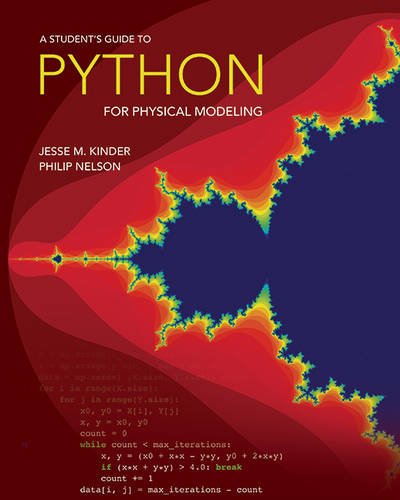
Sinossi
Python is a computer programming language that is rapidly gaining popularity throughout the sciences. A Student's Guide to Python for Physical Modeling aims to help you, the student, teach yourself enough of the Python programming language to get started with physical modeling. You will learn how to install an open-source Python programming environment and use it to accomplish many common scientific computing tasks: importing, exporting, and visualizing data; numerical analysis; and simulation. No prior programming experience is assumed.
This tutorial focuses on fundamentals and introduces a wide range of useful techniques, including:
- Basic Python programming and scripting
- Numerical arrays
- Two- and three-dimensional graphics
- Monte Carlo simulations
- Numerical methods, including solving ordinary differential equations
- Image processing
- Animation
Le informazioni nella sezione "Riassunto" possono far riferimento a edizioni diverse di questo titolo.
Informazioni sull?autore
Jesse M. Kinder is assistant professor of physics at the Oregon Institute of Technology. Philip Nelson is professor of physics at the University of Pennsylvania. He is the author of Biological Physics and Physical Models of Living Systems.
Dalla quarta di copertina
"Kinder and Nelson's engaging introduction to scientific programming in Python is careful and thorough, and focuses on actual essentials. Bread-and-butter concepts and techniques, belonging in every computational scientist's toolbox, are presented with well-thought-out examples drawn from daily research practice. This is a clever text, inviting students to take that most important step: to dive right in and start coding."--Cornelis Storm, Eindhoven University of Technology
"Kinder and Nelson have written a friendly and succinct, yet surprisingly comprehensive, introduction to scientific programming in Python. It's written not just for computational scientists, but for anyone who needs to plot and analyze experimental data, numerically solve equations, or learn the basics of programming. Even students who have experience in programming will appreciate the thought-provoking exercises and guidelines for getting the most out of Python."
--Vinothan N. Manoharan, Harvard University
"This book is tailor-made for physical scientists beginning to do computation. More than in any other programming book I've read, the authors are conscientious--they anticipate and troubleshoot the areas of confusion readers might encounter. Kinder and Nelson carefully and effectively guide readers toward the goal of formulating a computational problem and solving it."--Justin Bois, California Institute of Technology
"Like patient driving instructors, Kinder and Nelson guide the hands of novice programming students from the get-go, helping them to avoid obstacles and crashes. By the end of the book, students should be racing around confidently like pros, using Python to solve scientific problems of data analysis, modeling, and visualization. A great textbook for a first course in modern scientific programming in any context, and one that I'll be using myself."--Garnet Kin-Lic Chan, Princeton University
"This book covers the basics of Python programming language, with an emphasis on physical modeling. It provides a very useful introduction to Python for undergraduate students and others who have never programmed before."--Zeljko Ivezic, University of Washington
"This is an excellent introductory text, aimed at those with little to no experience in programming. In a clear and concise manner, the authors cover or touch upon all the important aspects of computational science in Python. They guide readers by explaining how to best perform certain common tasks in scientific computing. The book's examples and user exercises are well selected."--Quentin Caudron, Princeton University
Le informazioni nella sezione "Su questo libro" possono far riferimento a edizioni diverse di questo titolo.
Altre edizioni note dello stesso titolo
Risultati della ricerca per A Student's Guide to Python for Physical Modeling
A Student's Guide to Python for Physical Modeling
Da: HPB-Red, Dallas, TX, U.S.A.
hardcover. Condizione: Very Good. Connecting readers with great books since 1972! Used textbooks may not include companion materials such as access codes, etc. May have some wear or limited writing/highlighting. We ship orders daily and Customer Service is our top priority! Codice articolo S_449069279
Compra usato
Quantità: 1 disponibili
A Student's Guide to Python for Physical Modeling
Da: Labyrinth Books, Princeton, NJ, U.S.A.
Condizione: New. Codice articolo 181389
Compra nuovo
Quantità: 2 disponibili

